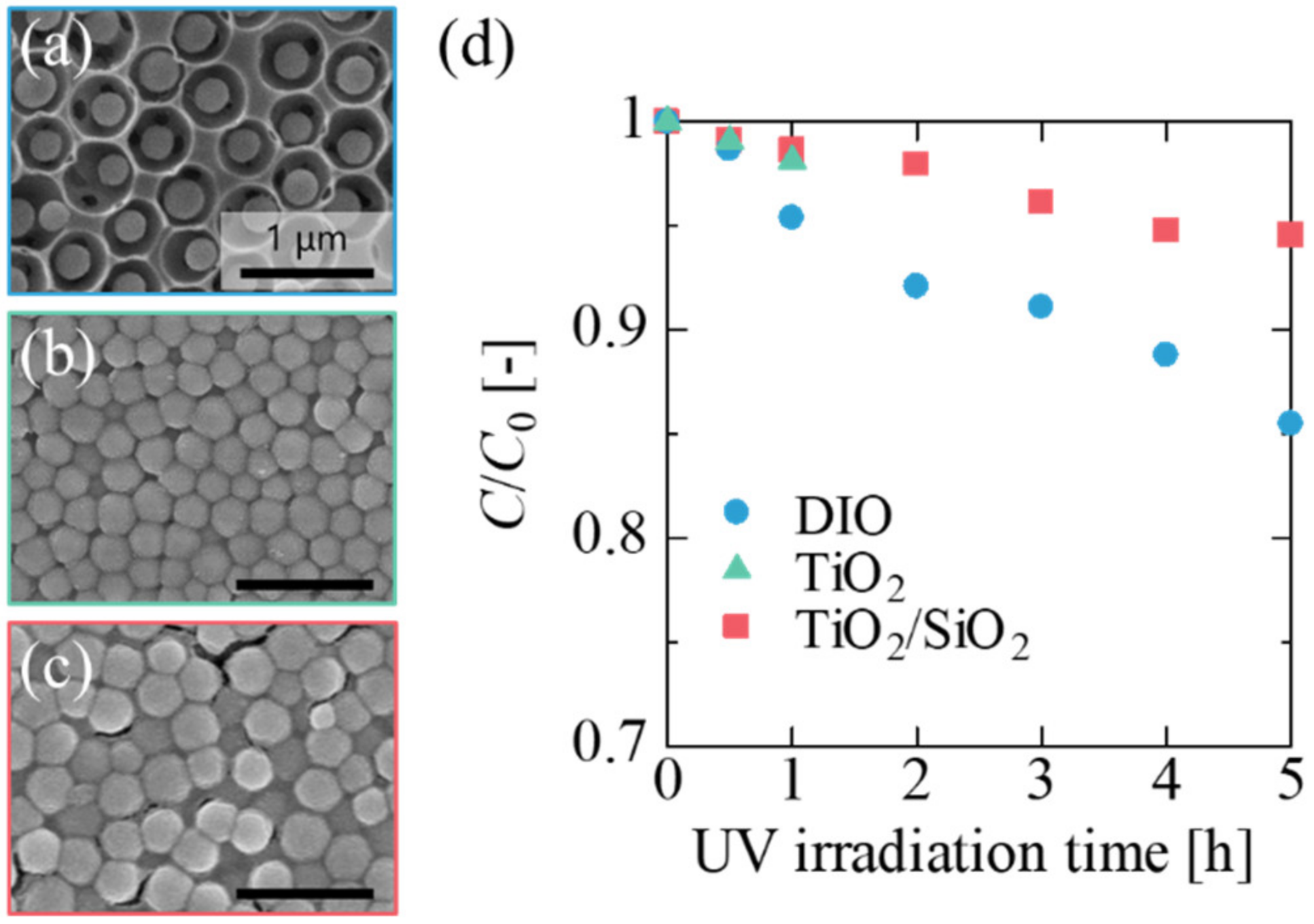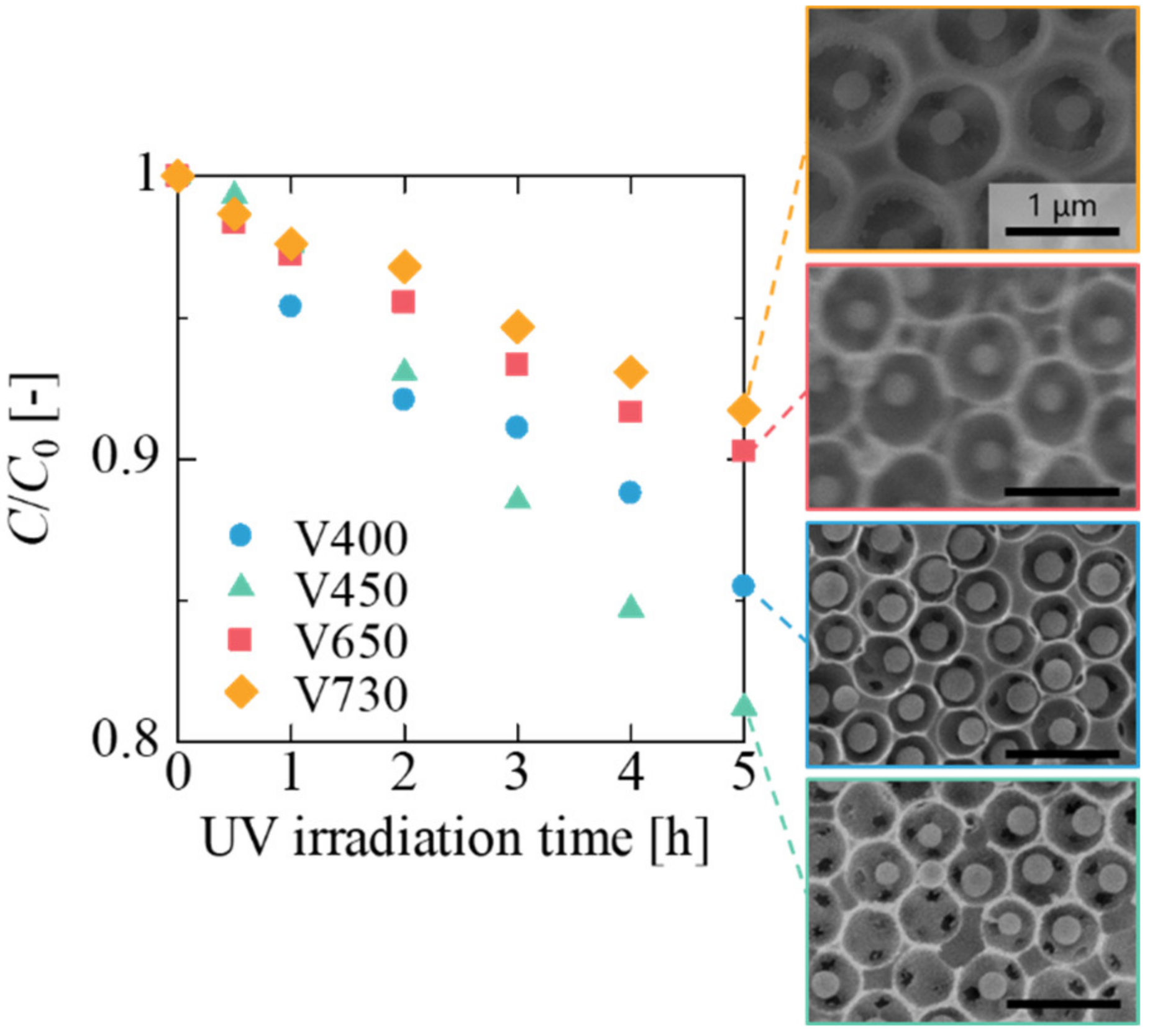Double-Inverse-Opal-Structured Particle Assembly as a Novel Immobilized Photocatalytic Material
Abstract
:1. Introduction
2. Materials and Methods
2.1. Materials
2.2. Fabrication of the DIO Photocatalytic Assembly
2.3. Characterization of the DIO on Photocatalytic Activities
2.4. Characterization
3. Results and Discussion
3.1. Photocatalytic Activity of the DIO Photocatalytic Assembly
3.2. Effect of Void Size and Film Thickness on Photocatalytic Activity
4. Conclusions
Supplementary Materials
Author Contributions
Funding
Acknowledgments
Conflicts of Interest
References
- Suryaman, D.; Hasegawa, K. Biological and photocatalytic treatment integrated with separation and reuse of titanium dioxide on the removal of chlorophenols in tap water. J. Hazard. Mater. 2010, 183, 490–496. [Google Scholar] [CrossRef] [PubMed]
- Al-Mamun, M.R.; Kader, S.; Islam, M.S.; Khan, M.Z.H. Photocatalytic activity improvement and application of UV-TiO2 photocatalysis in textile wastewater treatment: A review. J. Environ. Chem. Eng. 2019, 7, 103248. [Google Scholar] [CrossRef]
- Horikoshi, S.; Serpone, N. Can the photocatalyst TiO2 be incorporated into a wastewater treatment method? Background and prospects. Catal. Today 2020, 340, 334–346. [Google Scholar] [CrossRef]
- Fujishima, A.; Honda, K. Electrochemical Photolysis of Water at a Semiconductor Electrode. Nature 1972, 238, 38–40. [Google Scholar] [CrossRef] [PubMed]
- Singh, R.; Dutta, S. A review on H2 production through photocatalytic reactions using TiO2/TiO2-assisted catalysts. Fuel 2018, 220, 607–620. [Google Scholar] [CrossRef]
- Corredor, J.; Rivero, M.J.; Rangel, C.M.; Gloaguen, F.; Ortiz, I. Comprehensive review and future perspectives on the photocatalytic hydrogen production. J. Chem. Technol. Biotechnol. 2019, 94, 3049–3063. [Google Scholar] [CrossRef] [Green Version]
- Chou, C.S.; Yang, R.Y.; Weng, M.H.; Yeh, C.H. Study of the Applicability of TiO2/Dye Composite Particles for a Dye-Sensitized Solar Cell. Adv. Powder Technol. 2008, 19, 541–558. [Google Scholar] [CrossRef]
- Shengyuan, Y.; Peining, Z.; Nair, A.S.; Ramakrishna, S. Rice grain-shaped TiO2 mesostructures—synthesis, characterization and applications in dye-sensitized solar cells and photocatalysis. J. Mater. Chem. 2011, 21, 6541. [Google Scholar] [CrossRef]
- Chong, M.N.; Jin, B.; Chow, C.W.; Saint, C. Recent developments in photocatalytic water treatment technology: A review. Water Res. 2010, 44, 2997–3027. [Google Scholar] [CrossRef]
- Bamwenda, G.R.; Tsubota, S.; Nakamura, T.; Haruta, M. Photoassisted hydrogen production from a water-ethanol solution: A comparison of activities of Au□TiO2 and Pt□TiO2. J. Photochem. Photobiol. A Chem. 1995, 89, 177–189. [Google Scholar] [CrossRef]
- Primo, A.; Corma, A.; García, H. Titania supported gold nanoparticles as photocatalyst. Phys. Chem. Chem. Phys. 2011, 13, 886–910. [Google Scholar] [CrossRef] [PubMed]
- Liu, X.; Iocozzia, J.; Wang, Y.; Cui, X.; Chen, Y.; Zhao, S.; Li, Z.; Lin, Z. Noble metal–metal oxide nanohybrids with tailored nanostructures for efficient solar energy conversion, photocatalysis and environmental remediation. Energy Environ. Sci. 2017, 10, 402–434. [Google Scholar] [CrossRef]
- Cong, Y.; Zhang, J.; Chen, F.; Anpo, M. Synthesis and characterization of nitrogen-doped TiO2 nanophotocatalyst with high visible light activity. J. Phys. Chem. C 2007, 111, 6976–6982. [Google Scholar] [CrossRef]
- Byrne, C.; Subramanian, G.; Pillai, S.C. Recent advances in photocatalysis for environmental applications. J. Environ. Chem. Eng. 2018, 6, 3531–3555. [Google Scholar] [CrossRef]
- Cheng, L.; Xiang, Q.; Liao, Y.; Zhang, H. CdS-Based photocatalysts. Energy Environ. Sci. 2018, 11, 1362–1391. [Google Scholar] [CrossRef]
- Kudo, A.; Omori, K.; Kato, H. A novel aqueous process for preparation of crystal form-controlled and highly crystalline BiVO4 powder from layered vanadates at room temperature and its photocatalytic and photophysical properties. J. Am. Chem. Soc. 1999, 121, 11459–11467. [Google Scholar] [CrossRef]
- Malathi, A.; Madhavan, J.; Ashokkumar, M.; Arunachalam, P. A review on BiVO4 photocatalyst: Activity enhancement methods for solar photocatalytic applications. Appl. Catal. A Gen. 2018, 555, 47–74. [Google Scholar]
- Wang, X.; Maeda, K.; Thomas, A.; Takanabe, K.; Xin, G.; Carlsson, J.M.; Domen, K.; Antonietti, M. A metal-free polymeric photocatalyst for hydrogen production from water under visible light. Nat. Mater. 2009, 8, 76–80. [Google Scholar] [CrossRef]
- Ong, W.-J.; Tan, L.-L.; Ng, Y.H.; Yong, S.-T.; Chai, S.-P. Graphitic Carbon Nitride (g-C3N4)-Based Photocatalysts for Artificial Photosynthesis and Environmental Remediation: Are We a Step Closer To Achieving Sustainability? Chem. Rev. 2016, 116, 7159–7329. [Google Scholar] [CrossRef]
- Kudo, A.; Miseki, Y. Heterogeneous photocatalyst materials for water splitting. Chem. Soc. Rev. 2009, 38, 253–278. [Google Scholar] [CrossRef]
- Colombo, E.; Ashokkumar, M. Comparison of the photocatalytic efficiencies of continuous stirred tank reactor (CSTR) and batch systems using a dispersed micron sized photocatalyst. RSC Adv. 2017, 7, 48222–48229. [Google Scholar] [CrossRef] [Green Version]
- Shibata, H.; Sakai, H.; Rangsunvigit, P.; Hirano, T.; Abe, M. Preparation and photocatalytic activity of titania particulate film with silica as binder. Surf. Coat. Int. Part B Coat. Trans. 2003, 86, 125–130. [Google Scholar] [CrossRef]
- Li, D.; Zheng, H.; Wang, Q.; Wang, X.; Jiang, W.; Zhang, Z.; Yang, Y. A novel double-cylindrical-shell photoreactor immobilized with monolayer TiO2-coated silica gel beads for photocatalytic degradation of Rhodamine B and Methyl Orange in aqueous solution. Sep. Purif. Technol. 2014, 123, 130–138. [Google Scholar] [CrossRef]
- Curti, M.; Mendive, C.B.; Grela, M.A.; Bahnemann, D.W. Stopband tuning of TiO2 inverse opals for slow photon absorption. Mater. Res. Bull. 2017, 91, 155–165. [Google Scholar] [CrossRef]
- Wu, X.-Q.; Shao, Z.-D.; Liu, Q.; Xie, Z.; Zhao, F.; Zheng, Y.-M. Flexible and porous TiO2/SiO2/carbon composite electrospun nanofiber mat with enhanced interfacial charge separation for photocatalytic degradation of organic pollutants in water. J. Colloid Interface Sci. 2019, 553, 156–166. [Google Scholar] [CrossRef] [PubMed]
- Manassero, A.; Satuf, M.L.; Alfano, O.M. Photocatalytic reactors with suspended and immobilized TiO2: Comparative efficiency evaluation. Chem. Eng. J. 2017, 326, 29–36. [Google Scholar] [CrossRef]
- Ruhl, T.; Spahn, P.; Hermann, C.; Jamois, C.; Hess, O. Double-Inverse-Opal Photonic Crystals: The Route to Photonic Bandgap Switching. Adv. Funct. Mater. 2006, 16, 885–890. [Google Scholar] [CrossRef]
- Yamada, K.; Nagao, D.; Ishii, H.; Konno, M. Fabrication of Double Inverse Opals via Binary Colloidal Crystals of Inorganic-Organic Core-Shell Particles and Inorganic Nanoparticles. J. Chem. Eng. Jpn. 2015, 48, 933–936. [Google Scholar] [CrossRef]
- Yamada, K.; Nagao, D.; Ishii, H.; Konno, M. Optimized Thermal Treatment for Preparation of Double Inverse Opals Incorporating Movable Cores. J. Chem. Eng. Jpn. 2017, 50, 64–67. [Google Scholar] [CrossRef] [Green Version]
- Rhee, D.K.; Jung, B.; Kim, Y.H.; Yeo, S.J.; Choi, S.J.; Rauf, A.; Han, S.; Yi, G.R.; Lee, D.; Yoo, P.J. Particle-nested inverse opal structures as hierarchically structured large-scale membranes with tunable separation properties. ACS Appl. Mater. Interfaces 2014, 6, 9950–9954. [Google Scholar] [CrossRef]
- Collins, G.; Armstrong, E.; McNulty, D.; O’Hanlon, S.; Geaney, H.; O’Dwyer, C. 2D and 3D photonic crystal materials for photocatalysis and electrochemical energy storage and conversion. Sci. Technol. Adv. Mater. 2016, 17, 563–582. [Google Scholar] [CrossRef] [PubMed] [Green Version]
- Hufziger, K.T.; Zrimsek, A.B.; Asher, S.A. Solid Deep Ultraviolet Diffracting Inverse Opal Photonic Crystals. ACS Appl. Nano Mater. 2018, 1, 7016–7024. [Google Scholar] [CrossRef]
- Péré, E.; Cardy, H.; Cairon, O.; Simon, M.; Lacombe, S. Quantitative assessment of organic compounds adsorbed on silica gel by FTIR and UV-VIS spectroscopies: The contribution of diffuse reflectance spectroscopy. Vib. Spectrosc. 2001, 25, 163–175. [Google Scholar] [CrossRef]
- Li, J.; Zheng, T. A comparison of chemical sensors based on the different ordered inverse opal films. Sens. Actuators B Chem. 2008, 131, 190–195. [Google Scholar] [CrossRef]
- Mine, E.; Hirose, M.; Nagao, D.; Kobayashi, Y.; Konno, M. Synthesis of submicrometer-sized titania spherical particles with a sol-gel method and their application to colloidal photonic crystals. J. Colloid Interface Sci. 2005, 291, 162–168. [Google Scholar] [CrossRef]
- Watanabe, K.; Ishii, H.; Konno, M.; Imhof, A.; van Blaaderen, A.; Nagao, D. Yolk/Shell Colloidal Crystals Incorporating Movable Cores with Their Motion Controlled by an External Electric Field. Langmuir 2017, 33, 296–302. [Google Scholar] [CrossRef]
- Namigata, H.; Watanabe, K.; Okubo, S.; Nagao, D. Polymer-coating of photocatalytic particles to prevent sintering in their calcination process. Colloids Surf. A Physicochem. Eng. Asp. 2020, 599, 124782. [Google Scholar] [CrossRef]
- Mine, E.; Hirose, M.; Kubo, M.; Kobayashi, Y.; Nagao, D.; Konno, M. Synthesis of submicron-sized titania-coated silica particles with a sol-gel method and their application to colloidal photonic crystals. J. Sol-Gel Sci. Technol. 2006, 38, 91–95. [Google Scholar] [CrossRef]
- Hou, C.; Hu, B.; Zhu, J. Photocatalytic Degradation of Methylene Blue over TiO2 Pretreated with Varying Concentrations of NaOH. Catalysts 2018, 8, 575. [Google Scholar] [CrossRef] [Green Version]
- Houas, A. Photocatalytic degradation pathway of methylene blue in water. Appl. Catal. B Environ. 2001, 31, 145–157. [Google Scholar] [CrossRef]
- Yeo, S.J.; Choi, G.H.; Yoo, P.J. Multiscale-architectured functional membranes utilizing inverse opal structures. J. Mater. Chem. A 2017, 5, 17111–17134. [Google Scholar] [CrossRef]
- Camera-Roda, G.; Santarelli, F. Optimization of the thickness of a photocatalytic film on the basis of the effectiveness factor. Catal. Today 2007, 129, 161–168. [Google Scholar] [CrossRef]
- Vezzoli, M.; Farrell, T.; Baker, A.; Psaltis, S.; Martens, W.N.; Bell, J.M. Optimal catalyst thickness in titanium dioxide fixed film reactors: Mathematical modelling and experimental validation. Chem. Eng. J. 2013, 234, 57–65. [Google Scholar] [CrossRef] [Green Version]
- Lim, S.Y.; Law, C.S.; Markovic, M.; Kirby, J.K.; Abell, A.D.; Santos, A. Engineering the Slow Photon Effect in Photoactive Nanoporous Anodic Alumina Gradient-Index Filters for Photocatalysis. ACS Appl. Mater. Interfaces 2018, 10, 24124–24136. [Google Scholar] [CrossRef] [Green Version]




Publisher’s Note: MDPI stays neutral with regard to jurisdictional claims in published maps and institutional affiliations. |
© 2020 by the authors. Licensee MDPI, Basel, Switzerland. This article is an open access article distributed under the terms and conditions of the Creative Commons Attribution (CC BY) license (http://creativecommons.org/licenses/by/4.0/).
Share and Cite
Namigata, H.; Watanabe, K.; Okubo, S.; Hasegawa, M.; Suga, K.; Nagao, D. Double-Inverse-Opal-Structured Particle Assembly as a Novel Immobilized Photocatalytic Material. Materials 2021, 14, 28. https://doi.org/10.3390/ma14010028
Namigata H, Watanabe K, Okubo S, Hasegawa M, Suga K, Nagao D. Double-Inverse-Opal-Structured Particle Assembly as a Novel Immobilized Photocatalytic Material. Materials. 2021; 14(1):28. https://doi.org/10.3390/ma14010028
Chicago/Turabian StyleNamigata, Hikaru, Kanako Watanabe, Saya Okubo, Masashi Hasegawa, Keishi Suga, and Daisuke Nagao. 2021. "Double-Inverse-Opal-Structured Particle Assembly as a Novel Immobilized Photocatalytic Material" Materials 14, no. 1: 28. https://doi.org/10.3390/ma14010028




